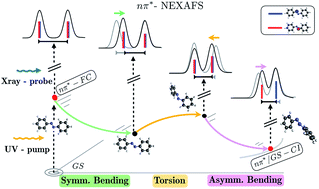Exploring the capabilities of optical pump X-ray probe NEXAFS spectroscopy to track photo-induced dynamics mediated by conical intersections
Abstract
X-ray spectroscopy is gaining a growing interest in the scientific community, as it represents a versatile and powerful experimental toolbox for probing the dynamics of both core and valence electronic excitations, nuclear motions and material structure, with element and site specificity. Among the various X-ray based techniques, near-edge X-ray absorption fine structure (NEXAFS) spectroscopy, which investigates the energy and probability of resonant core-to-valence transitions, has started to be applied to organic molecules: a recent UV-pump X-ray probe time-resolved NEXAFS experiment [Wolf et al., Nat. Commun., 2017, 8, 1] has shown the capability of the technique to provide information about the ultrafast internal conversion between the bright ππ* and the dark nπ* electronic states of the nucleobase thymine. In the present contribution we introduce an accurate theoretical approach for the simulation of NEXAFS spectra of organic molecules, employing azobenzene as a test case. The electronic structure calculations, which provide both energy levels and transition probabilities of core-to-valence excitations, were here performed with a high level multiconfigurational method, the restricted active space self consistent field (RASSCF/RASPT2). GS- and nπ*-NEXAFS spectra were obtained on the top of key molecular geometries (as the optimized cis, trans and conical intersection(s) structures) as well as along the fundamental isomerization coordinates (namely, symmetric and asymmetric bendings of the phenyl rings, and torsion around the central dihedral). We eventually characterize and explain the origin of the simulated signals, highlighting the specific signatures that make it possible to follow the excited state evolution from the nπ* Franck–Condon point, towards the conical intersection(s).

- This article is part of the themed collection: Quantum effects in complex systems


 Please wait while we load your content...
Please wait while we load your content...